Avoid the crowds: Six under-the-radar places in Venice you must visit
By Lee Tulloch
There’s the storied Venice that the tour guides show you and then there are the other Venices, the ones layered with history, the socially diverse and locally flavoured, with every narrow street, quiet square, empty canal – every stone, in fact – a new discovery.
Often the best way to find these parallel Venices is not to look for them at all. In short, to see Venice properly is to head off in any direction and expect to get lost.
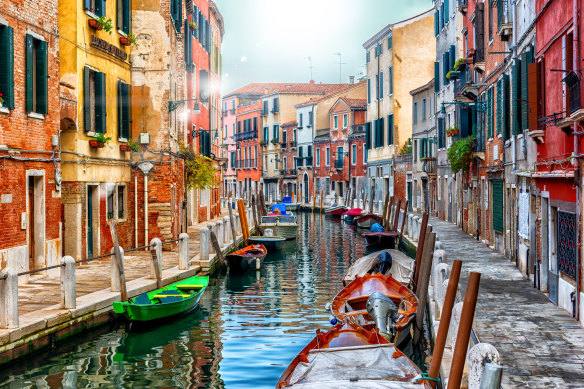
Get lost in Venice.Credit: iStock
But, typically, for most of us, with only a few days for a visit and not a lifetime, one sure and rewarding approach is to explore the city district by district.
Venice has six districts, or sestiere, and more than 100 islands with each neighbourhood possessing its own, distinct character, from the former Jewish ghetto in Cannaregio to the busy urban crossroads that is Santa Croce.
Even if you’re there for a day or two, don’t stick to the city’s famous highlights, as magnificent as they are.
Keep walking, over bridges and canals, down narrow calle or rios (canal streets), into neighbourhoods where kids play hopscotch and whole families take their evening passeggiata in beautiful waterfront parks.
It’s something that Melissa Conn, director of the Venice office of Save Venice Inc, advocates.
Add to that to ensure you get the timing of your visit right, if possible, for the lowest impact on the famously fragile city which faces myriad threats including everything from wash damage from motorboats on its canals to ongoing pressures on rental accommodation affecting its remaining residents.
“Explore all areas of Venice and enjoy the city at off-season times such as November or January,” she says, adding that “tourists should [also] avoid being in groups and seek travel opportunities as individuals”.
Take the fabulous vaporetto, or water bus service to the further reaches of the Grand Canal or across the Giudecca lagoon. If you do get lost, you can’t go too far – you’ll end up in the water – so best to follow this Traveller guide to getting the most out of La Serenissima, and, most importantly, to doing the right thing by it.
Classic Venice, San Marco
Does anyone go to Venice without visiting the famed Piazza di San Marco? St Mark’s Square (as it’s known in English) was the heart of the city’s trade when it was the capital of the Italian Republic (810-1797) and a major financial and military power during the Middle Ages and the Renaissance.
Merchant Marco Polo launched his epic journey along the Silk Road from those steps. Known as the Venetian’s “lounge room”, it’s still the city’s gathering place.
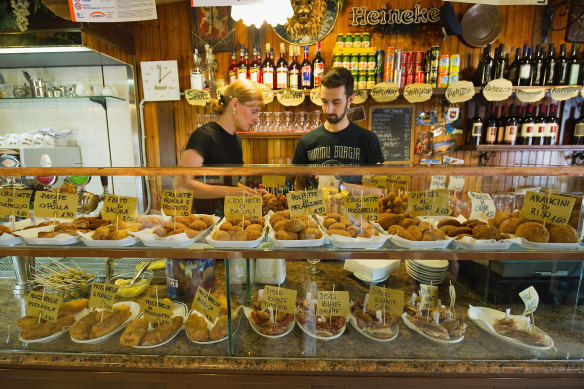
Staff lay out cicchetti for lunchtime service at a bacaro. Credit: Getty Images
Most tourists come by day to visit the Basilica of San Marco (a transcendent experience), climb its Campanile, or bell tower, sip a pricey Bellini at Harry’s Bar and wander through the ornate rooms of the Doge’s Palace.
It’s the part of Venice where the prices are guaranteed to seem a rip-off, where pickpockets lurk, and where there’s a logjam of crowds in the Merceria, or shopping streets behind the square.
But at night when the cruise crowds go back to their ships, the square empties and can be magical, especially in warmer months, with people dancing to the orchestras outside Caffe Florian and kids throwing iridescent toys into the air.
The sestiere of San Marco is Venice’s smallest in terms of population, and once you push past the crowds, it has its own quieter neighbourhoods well worth exploring.
In the streets behind the restored opera house, La Fenice, you might stumble on a quiet cafe in a small square, or at night a concert in Campo Santo Stefano or Campo Bartolomeo.
A lesser-known landmark is the Scala Contarini del Bovolo, an external spiral staircase built in 1499 that rises spectacularly from a small square near Campo Manin.
The Museo Fortuny, housed in the atmospheric palazzo and studio of Venice’s great inventor and designer, Mariano Fortuny, is well worth a diversion, especially for those interested in fashion, photography and theatre. Palazzo Grassi on the Grand Canal houses the modern art collection of Francois Pinault, including 20th-century photography.
T Fondaco dei Tedeschi is a luxury shopping centre with a fabulous – and free - terrace that boasts the best views of the city.
Vaporetto stops S. Marco Giardinetti, S. Samuele Rialto
Stay Baglioni Hotel Luna is a grand hotel right in the heart of San Marco, housed in a palazzo which dates to the 12th century. It’s tucked away just behind the piazza, is extremely convenient for getting around, and a perfect refuge when the crowds get too much. See lhw.com
Cultural Venice, Castello
Castello is the district most familiar to art lovers as it’s the location of the Venice Biennale of Art. (There’s an architecture biennale every other year.) The world’s most prestigious art fair takes place in the Giardini, an expanse of formal gardens built by Napoleon at the start of the 19th century, and in the Arsenale, Venice’s largest shipyard.
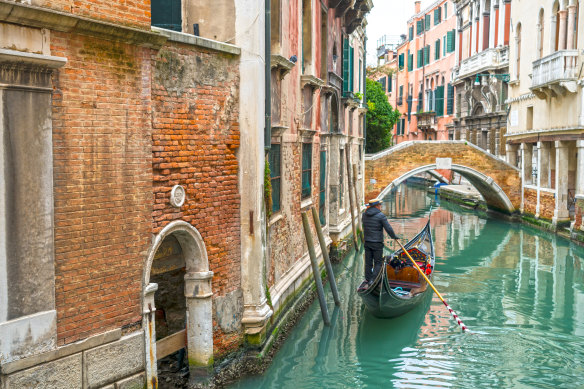
Getting there by gondola.Credit: iStock
Castello borders busy San Marco, but you only need to cross a couple of bridges to lose the crowds almost entirely.
It has a few lesser-known highlights, such as the subterranean pools in the crypt of San Zaccaria church, the remote church and convent of San Francesco della Vignia, with a beautiful facade by Palladio and a vineyard and herb garden in its cloisters, and the Museo Palazzo Grimani, the restored 16th-century palace of a former Doge, decorated with exquisite marble carvings and statues from the Renaissance.
The Gothic Chiesa Santi Giovanni e Paolo is one of the largest churches in the city and features a Bellini altarpiece.
The Scuola Dalmata di San Giorgio degli Schiavoni is in Castello, with its early 15th-century paintings by Carpaccio now being restored by Save Venice.
One spot you’re likely to find tourists is the Libreria Aqua Alta, the “bookstore of the high water”, where you can wander though rooms stuffed wall-to-wall with old books and magazines, many stored in old bathtubs.
The courtyard is piled with books ruined by flooding and is the haunt of Instagrammers, who pose against the walls of once-sodden books. Still worth a visit though, even if just to pat the resident cats.
The great joy of Castello is that it’s a lively, functioning neighbourhood, full of pharmacies, cobblers, sports clubs, alimentari, and bars, where the barges bring fruit and vegetables each day, washing hangs on lines over the narrow streets, and at night families take their passeggiata, or evening stroll, along one of Venice’s nicest streets, via Giuseppe Garibaldi.
The peaceful waterfront along the lagoon is also the best place to catch Technicolor sunsets.
Vaporetto stops San Zaccaria, Giardini, Celestia
Stay Ca’ di Dio, a former 13th-century convent and hospital turned five-star waterfront hotel, with central garden and splendid porthole views over the Giudecca Canal from some suites.
Gourmet Venice, San Polo
San Polo, Venice’s smallest sestiere, is tucked into the curve of the Grand Canal and getting there by vaporetto offers one of the most picturesque stretches of the main thoroughfare and the palaces on either side.
Locals cross the canal using small gondolas called traghetto for only €0.70. It’s €2 for tourists but that’s great value for an authentic experience that can be exhilarating in the choppy, crowded waters of the canal. Find them near the Gritti Palace or S.Toma water taxi station.
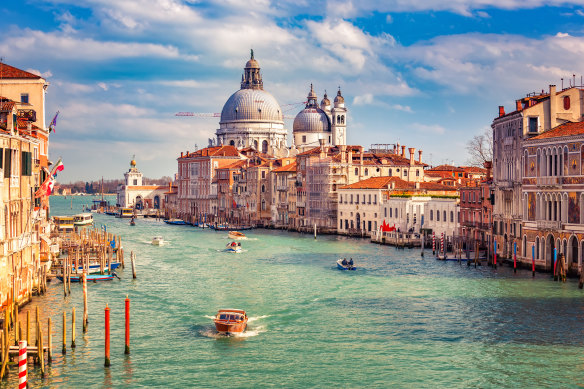
Grand Canal and Basilica Santa Maria della Salute.Credit: iStock
The district is most famous for the Rialto Bridge, where you’ll certainly see throngs of tourists taking selfies of themselves lying along the bridge’s arch, and for the market of gleaming fresh produce and locally caught fish.
Around the market there are dozens of small bars selling small bites called cicchetti, and they’re often open early to serve delivery people and market stallholders.
If you go early, about 7am to 7.30am as they’re setting up, you’ll miss many of the tour groups that consider the market a must-see highlight.
Head towards the hub of the neighbourhood at the Campo San Polo, where it’s far enough away from the tourists to find lots of cheaper bars and restaurants and children playing hopscotch after school.
This is Venice’s oldest neighbourhood, and the square was once the place of bullfights and masquerade balls. It’s still one of most popular squares during the Carnivale and there are open-air screenings during the Film Festival in late summer.
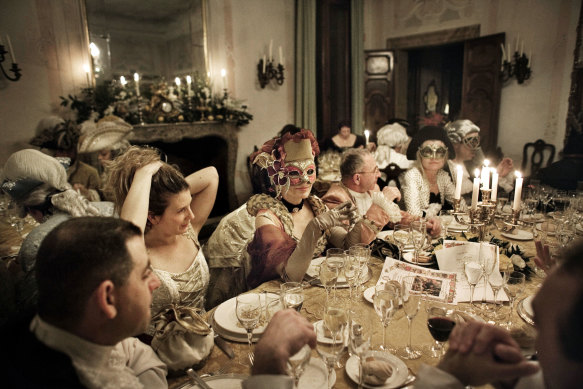
Masked guests at a party during Carnivale.Credit: Getty Images
San Polo is not without its cultural highlights. The Gothic Basilica of Santa Maria Gloriosa dei Frari is where you’ll find some remarkable Titian masterpieces, including Madonna di Ca’ Pesaro, and a beautiful altarpiece representing the Assumption.
The Scuola Grande di San Rocco has a similarly important collection of art, including impressive Tintorettos.
Vaporetto stops San Toma, San Silvestro, Rialto Mercado
Stay If you really want to live it up, the Aman Venice is housed in one of the city’s most beautiful palaces, Palazzo Papadopoli, and its owner, Count Giberto Arrivabene Valenti Gonzaga, still lives in part of it with his family.
Bohemian Venice, Dorsoduro
Peggy Guggenheim, the free-spirited American heiress with a bold and shrewd eye for contemporary art, famously lived in Dorsoduro sestiere in a palazzo previously occupied by the outrageous Marchesa Louisa Casati, who’d wander around Venice at night with her two cheetahs on diamond-studded leashes, her way lit by a retainer carrying a lamp.
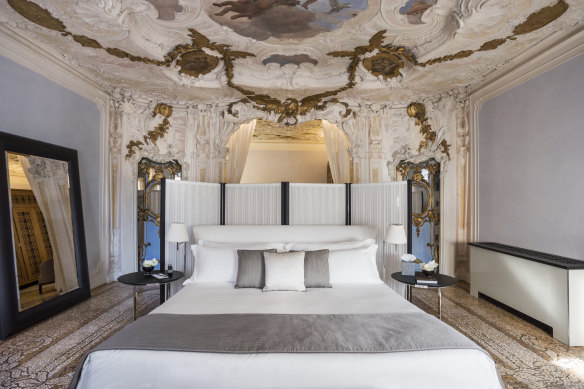
Aman Venice hotel.
That building now houses the Peggy Guggenheim Collection, Italy’s second-most visited museum. The spirit of these two wealthy bohemians infuses the neighbourhood, which is full of small galleries, street artists and students from the Ca’ Foscari University.
Along from the Guggenheim palazzo is the Gallerie dell’Accademia, which contains the most important collection of Venetian art in the world.
A lesser-known highlight of Dorsoduro is Palazzo Ca’Rezzonico, the museum of 18th-century Venice, housed in a lavish palace where poet Robert Browning and songwriter Cole Porter lived in different eras, and which houses a wonderful collection of art and artefacts from that era, including the reconstruction of entire bedrooms and a pharmacy.
The same architect who built Ca’ Rezzonico designed the baroque Basilica di Santa Maria della Salute at the entrance of the Grand Canal, which was created to honour the city’s deliverance from the plague of 1630.
It’s worth visiting for its Tintorettos and Titians and its magnificent domed interior. Each November 21 it’s the site of one of Venice’s most popular festivals.
Dorsoduro is the Venetian neighbourhood that’s most alive at night. The epicentre of this is Campo Santa Margherita. Once a hotbed of left-wing activism and a gathering place for workers, poets and craftsmen, the 14th-century square now is a hangout for students, packed with cafes, pizzeria, inexpensive osteria and gelato bars.
Vaporetto stops Salute, Accademia, Rezzonic
Stay The romantic canal front Hotel Pensione Accademia was formerly the Russian Embassy and is well-positioned for visiting the Peggy Guggenheim and the Accademia.
Grassroots Venice, Giudecca
It’s only a short vaporetto ride across the lagoon to one of Venice’s most peaceful and beautiful neighbourhoods. Giudecca is strictly part of Dorsoduro sestiere but it feels different to anywhere else in the city.
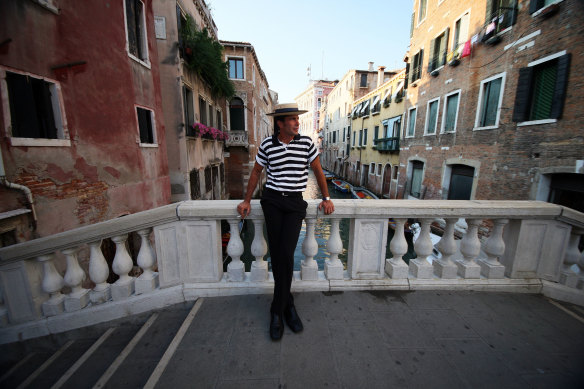
A gondolier takes a break.Credit: Getty Images
For those who make the trip to the island (eight islets connected by canals) they’re rewarded with the best views of San Marco along its elegant waterfront promenade, which is lined with Gothic villas, Renaissance and baroque houses, old convents, warehouses, granaries and churches, including Palladio’s domed church, Il Redentore, site of a wonderful regatta each July.
Giudecca was once very industrial, populated by cement factories, flour mills, textile mills, breweries, silos and incinerators. The shipyards dominated the centre of the island and still operate. Mariano Fortuny opened his fabric-making factory there in 1919 and the showrooms and garden can be visited.
Now much of it has been converted to artisans’ workshops and restaurants and chic little bars. But the island remains working class at heart, full of grocer’s shops, fruit markets, bakeries and laundries.
In the Casa di Reclusione Femminile (women’s prison), female inmates grow vegetables and sell their produce on Thursdays at a market outside the walls. Giudecca is also notable for its many private gardens and narrow rios or canal streets.
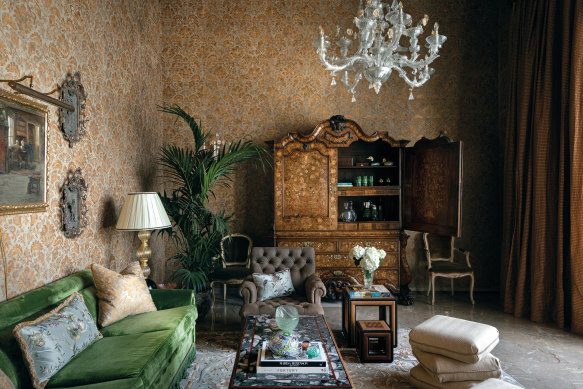
Hotel Cipriani.
Vaporetto stops Zitelle, Redentore, Palanca
Stay Giudecca has an extraordinary hotel at each end, the superb five-star Belmond Hotel Cipriani which overlooks the Isola di Giorgio Maggiore and the Hilton Molino Stucky, an imposing redbrick edifice that was once a flour mill.
Unvarnished Venice, Santa Croce
Santa Croce is considered Venice’s most humble district, mostly due to it being the city’s transport hub, with much of its area dedicated to the large bus station at Piazzale Roma, and the big car park that is the reclaimed area of Tronchetto.
If you’re staying any time in the city, you might find yourself in Piazzale Roma buying a Venizia Unica transport pass. (The tourist ones are available at vaporetto stops or online.) This is the only neighbourhood that allows cars.
Santa Croce still has its moments. Away from the transport hubs it’s the least touristy district of all and in the winding streets real life carries on.
The Natural History Museum is here, as is Ca’ Pesaro, a waterfront palazzo built in 1709, which houses two museums, the International Gallery of Modern Art and the Oriental Art Museum. Fans of design shouldn’t miss the Museum and Study Centre of the History of Fabrics and Costumes and Perfume, housed in the Palazzo Mocenigo, where Lord Byron once rented rooms.
If you’re looking for an authentic snack, the Bacareto da Lele on the Fondamenta dei Tolentini is a hole-in-the-wall that’s immensely popular with locals.
Vaporetto stops S. Stae, Riba di Biasio, P. Le Roma
Stay The charming Santa Croce Boutique Hotel is only a 10-minute walk from the Santa Lucia train station, convenient if you’re planning to travel to and from Venice by train.
Relaxed Venice, Cannaregio
Cannaregio is Venice’s northernmost district and its main promenade, Fondamente Nuove, can be packed with people, especially in the evenings, when locals and tourists alike stroll along the waterfront with little paper cups filled with fried seafood known as fritoin.
Because it’s the second largest sestiere, it has many streets where tourists never wander. It can be sleepy by day yet alive at night.
Cannaregio’s highlight for many is the Jewish Ghetto, where Shakespeare set The Merchant of Venice. The history behind it is intriguing. The ghetto was established in 1516 at the behest of Jewish leaders, who wanted a place where they could own property and be protected.
Jews were confined by curfew to this small area, where the mostly merchant class was allowed to trade and live. As the community grew to about 5000 people in the 17th century (squeezed onto a tiny islet) they built upwards, making it arguably the world’s first vertical city.
Here, you can find five beautiful synagogues, representing different ethnic groups, a yeshiva, kosher bakeries, and a museum under restoration. Only about 30 of approximately 450 Jews in Venice live in the ghetto now (it was abolished in 1797) but its quiet streets and squares feel as if little time has passed.
A tour is recommended to access the synagogues, just turn up at Campo di Ghetto Nuovo to buy a ticket.
It’s also worth visiting Cannaregio for the Orsoni Furnace, the last furnace permitted to operate in Venice.
This magical museum includes a colour library that has catalogued more than 3500 colours of Venetian smalti, or the coloured opaque glass often used in murals. The Madonna del Orto is one of the loveliest Gothic churches. Tintoretto, who is buried here, painted many of large works in the church, including the altar.
The Gothic palace of Ca’D’Oro was once covered in gold. It is one of the most beautiful on the Grand Canal and displays the collection of a 19th-century Venetian nobleman, Giorgio Franchetti. One “secret” place is the Despar supermarket hidden in the magnificent 1916 art deco Teatro Italia on Strada Nuova.
Vaporetto stops S. Marcuola, Ca’D’Oro, Fond Nuove
Stay This district is full of quaint, affordable three-star hotels such as Hotel Ca’Dogaressa as well as a few kosher hotels, like the modest Rimon Place, overlooking Campo del Ghetto.
Five more ways to be a better Venice visitor
Don’t be a day tripper like most tourists. Plan to stay for a few days and explore the endlessly fascinating city in depth.
Avoid joining large tour groups, which clog up the narrow streets, making it difficult for locals to do their necessary shopping and getting about.
Support local businesses such as Venice’s many artisans, not cheap tourist shops.
Rolling suitcases damage the old pavements and make a horrible noise that disturbs the peace for those living over the streets. Use the hotel porter or find a porter-for-hire at the vaporetto stations.
Skip St Mark’s Square and the tourist hotspots during the day. Visit at night, when most of the cruise passengers have gone back to their ship and the locals come out.
The details
Fly
For four months of the European summer in 2024, Qantas will fly to Rome directly from Perth three days a week using Boeing 787 Dreamliner aircraft; the only direct flights between Australia and continental Europe. See qantas.com
Ride
The preferred green option is to then take a direct train from Rome Fiumicino airport to Venice railway stations Mestre or Santa Lucia, a journey of just over four hours. See italiarail.com
More
visit savevenice.org/donate
venice-museum.com
veneziaunica.it/en
The writer was a guest of Ca’di Dio, Aman Venice and Hotel Baglioni Luna.
Sign up for the Traveller Deals newsletter
Get exclusive travel deals delivered straight to your inbox. Sign up now.